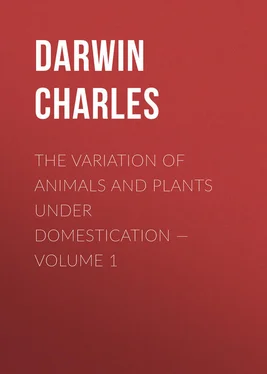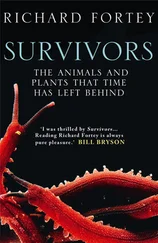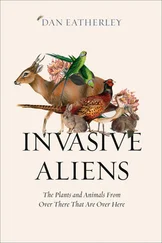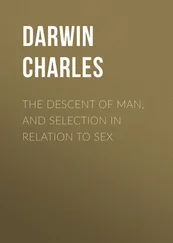Charles Darwin - The Variation of Animals and Plants under Domestication — Volume 1
Здесь есть возможность читать онлайн «Charles Darwin - The Variation of Animals and Plants under Domestication — Volume 1» — ознакомительный отрывок электронной книги совершенно бесплатно, а после прочтения отрывка купить полную версию. В некоторых случаях можно слушать аудио, скачать через торрент в формате fb2 и присутствует краткое содержание. Жанр: foreign_antique, foreign_prose, на английском языке. Описание произведения, (предисловие) а так же отзывы посетителей доступны на портале библиотеки ЛибКат.
- Название:The Variation of Animals and Plants under Domestication — Volume 1
- Автор:
- Жанр:
- Год:неизвестен
- ISBN:нет данных
- Рейтинг книги:5 / 5. Голосов: 1
-
Избранное:Добавить в избранное
- Отзывы:
-
Ваша оценка:
- 100
- 1
- 2
- 3
- 4
- 5
The Variation of Animals and Plants under Domestication — Volume 1: краткое содержание, описание и аннотация
Предлагаем к чтению аннотацию, описание, краткое содержание или предисловие (зависит от того, что написал сам автор книги «The Variation of Animals and Plants under Domestication — Volume 1»). Если вы не нашли необходимую информацию о книге — напишите в комментариях, мы постараемся отыскать её.
The Variation of Animals and Plants under Domestication — Volume 1 — читать онлайн ознакомительный отрывок
Ниже представлен текст книги, разбитый по страницам. Система сохранения места последней прочитанной страницы, позволяет с удобством читать онлайн бесплатно книгу «The Variation of Animals and Plants under Domestication — Volume 1», без необходимости каждый раз заново искать на чём Вы остановились. Поставьте закладку, и сможете в любой момент перейти на страницу, на которой закончили чтение.
Интервал:
Закладка:
That many breeds of cattle have originated through variation, independently of descent from distinct species, we may infer from what we see in South America, where the genus Bos was not endemic, and where the cattle which now exist in such vast numbers are the descendants of a few imported from Spain and Portugal. In Columbia, Roulin (3/63. 'Mem. de 1'Institut present. par divers Savans' tome 6 1835 page 333. For Brazil see 'Comptes Rendus' June 15, 1846. See Azara 'Quadrupedes du Paraguay' tome 2 pages 359, 361.) describes two peculiar breeds, namely, pelones, with extremely thin and fine hair, and calongos, absolutely naked. According to Castelnau there are two races in Brazil, one like European cattle, the other different, with remarkable horns. In Paraguay, Azara describes a breed which certainly originated in S. America, called chivos, "because they have straight vertical horns, conical, and very large at the base." He likewise describes a dwarf race in Corrientes, with short legs and a body larger than usual. Cattle without horns, and others with reversed hair, have also originated in Paraguay.
Another monstrous breed, called niatas or natas, of which I saw two small herds on the northern bank of the Plata, is so remarkable as to deserve a fuller description. This breed bears the same relation to other breeds, as bull or pug dogs do to other dogs, or as improved pigs, according to H. von Nathusius, do to common pigs. (3/64. 'Schweineschadel' 1864 s. 104. Nathusius states that the form of skull characteristic in the niata cattle occasionally appears in European cattle; but he is mistaken, as we shall hereafter see, in supposing that these cattle do not form a distinct race. Prof. Wyman, of Cambridge, United States, informs me that the common cod- fish presents a similar monstrosity, called by the fishermen "bull-dog cod." Prof. Wyman also concluded, after making numerous inquiries in La Plata, that the niata cattle transmit their peculiarities or form a race.) Rutimeyer believes that these cattle belong to the primigenius type. (3/65 'Ueber Art des zahmen Europ. Rindes' 1866 s. 28.) The forehead is very short and broad, with the nasal end of the skull, together with the whole plane of the upper molar-teeth, curved upwards. The lower jaw projects beyond the upper, and has a corresponding upward curvature. It is an interesting fact that an almost similar confirmation characterizes, as I am informed by Dr. Falconer, the extinct and gigantic Sivatherium of India, and is not known in any other ruminant. The upper lip is much drawn back, the nostrils are seated high up and are widely open, the eyes project outwards, and the horns are large. In walking the head is carried low, and the neck is short. The hind legs appear to be longer, compared with the front legs, than is usual. The exposed incisor teeth, the short head and upturned nostrils, give these cattle the most ludicrous, self-confident air of defiance. The skull which I presented to the College of Surgeons has been thus described by Professor Owen (3/66. 'Descriptive Cat. of Ost. Collect. of College of Surgeons' 1853 page 624. Vasey in his 'Delineations of the Ox-tribe' has given a figure of this skull; and I sent a photograph of it to Prof. Rutimeyer.) "It is remarkable from the stunted development of the nasals, premaxillaries, and fore-part of the lower jaw, which is unusually curved upwards to come into contact with the premaxillaries. The nasal bones are about one-third the ordinary length, but retain almost their normal breadth. The triangular vacuity is left between them, the frontal and lachrymal, which latter bone articulates with the premaxillary, and thus excludes the maxillary from any junction with the nasal." So that even the connexion of some of the bones is changed. Other differences might be added: thus the plane of the condyles is somewhat modified, and the terminal edge of the premaxillaries forms an arch. In fact, on comparison with the skull of a common ox, scarcely a single bone presents the same exact shape, and the whole skull has a wonderfully different appearance.
The first brief published notice of this race was by Azara, between the years 1783-96; but Don F. Muniz, of Luxan, who has kindly collected information for me, states that about 1760 these cattle were kept as curiosities near Buenos Ayres. Their origin is not positively known, but they must have originated subsequently to the year 1552, when cattle were first introduced. Senor Muniz informs me that the breed is believed to have originated with the Indians southward of the Plata. Even to this day those reared near the Plata show their less civilised nature in being fiercer than common cattle, and in the cow, if visited too often, easily deserting her first calf. The breed is very true, and a niata bull and cow invariably produce niata calves. The breed has already lasted at least a century. A niata bull crossed with a common cow, and the reverse cross, yield offspring having an intermediate character, but with the niata character strongly displayed. According to Senor Muniz, there is the clearest evidence, contrary to the common belief of agriculturists in analogous cases, that the niata cow when crossed with a common bull transmits her peculiarities more strongly than does the niata bull when crossed with a common cow. When the pasture is tolerably long, these cattle feed as well as common cattle with their tongue and palate; but during the great droughts, when so many animals perish on the Pampas, the niata breed lies under a great disadvantage, and would, if not attended to, become extinct; for the common cattle, like horses, are able to keep alive by browsing with their lips on the twigs of trees and on reeds: this the niatas cannot so well do, as their lips do not join, and hence they are found to perish before the common cattle. This strikes me as a good illustration of how little we are able to judge from the ordinary habits of an animal, on what circumstances, occurring only at long intervals of time, its rarity or extinction may depend. It shows us, also, how natural selection would have determined the rejection of the niata modification had it arisen in a state of nature.
Having described the semi-monstrous niata breed, I may allude to a white bull, said to have been brought from Africa, which was exhibited in London in 1829, and which has been well figured by Mr. Harvey. (3/67. Loudon's 'Magazine of Nat. Hist.' volume 1 1829 page 113. Separate figures are given of the animal, its hoofs, eye, and dewlap.) It had a hump, and was furnished with a mane. The dewlap was peculiar, being divided between its fore-legs into parallel divisions. Its lateral hoofs were annually shed, and grew to the length of five or six inches. The eye was very peculiar, being remarkably prominent, and "resembled a cup and ball, thus enabling the animal to see on all sides with equal ease; the pupil was small and oval, or rather a parallelogram with the ends cut off, and lying transversely across the ball." A new and strange breed might probably have been formed by careful breeding and selection from this animal.
I have often speculated on the probable causes through which each separate district in Great Britain came to possess in former times its own peculiar breed of cattle; and the question is, perhaps, even more perplexing in the case of Southern Africa. We now know that the differences may be in part attributed to descent from distinct species; but this cause is far from sufficient. Have the slight differences in climate and in the nature of the pasture, in the different districts of Britain, directly induced corresponding differences in the cattle? We have seen that the semi-wild cattle in the several British parks are not identical in colouring or size, and that some degree of selection has been requisite to keep them true. It is almost certain that abundant food given during many generations directly affects the size of a breed. (3/68. Low 'Domesticated Animals of the British Isles' page 264.) That climate directly affects the thickness of the skin and the hair is likewise certain: thus Roulin asserts (69 'Mem. de l'Institut present. Par divers Savans' tome 6 1835 page 332.) that the hides of the feral cattle on the hot Llanos "are always much less heavy than those of the cattle raised on the high platform of Bogota; and that these hides yield in weight and in thickness of hair to those of the cattle which have run wild on the lofty Paramos." The same difference has been observed in the hides of the cattle reared on the bleak Falkland Islands and on the temperate Pampas. Low has remarked (3/70. Idem pages 304, 368 etc.) that the cattle which inhabit the more humid parts of Britain have longer hair and thicker skins than other British cattle. When we compare highly improved stall-fed cattle with the wilder breeds, or compare mountain and lowland breeds, we cannot doubt that an active life, leading to the free use of the limbs and lungs, affects the shape and proportions of the whole body. It is probable that some breeds, such as the semi- monstrous niata cattle, and some peculiarities, such as being hornless, etc., have appeared suddenly owing to what we may call in our ignorance spontaneous variation; but even in this case a rude kind of selection is necessary, and the animals thus characterised must be at least partially separated from others. This degree of care, however, has sometimes been taken even in little-civilised districts, where we should least have expected it, as in the case of the niata, chivo, and hornless cattle in S. America.
Читать дальшеИнтервал:
Закладка:
Похожие книги на «The Variation of Animals and Plants under Domestication — Volume 1»
Представляем Вашему вниманию похожие книги на «The Variation of Animals and Plants under Domestication — Volume 1» списком для выбора. Мы отобрали схожую по названию и смыслу литературу в надежде предоставить читателям больше вариантов отыскать новые, интересные, ещё непрочитанные произведения.
Обсуждение, отзывы о книге «The Variation of Animals and Plants under Domestication — Volume 1» и просто собственные мнения читателей. Оставьте ваши комментарии, напишите, что Вы думаете о произведении, его смысле или главных героях. Укажите что конкретно понравилось, а что нет, и почему Вы так считаете.












